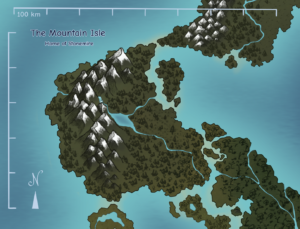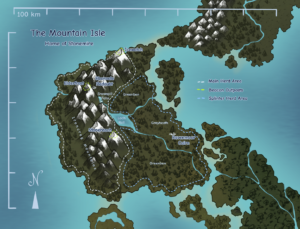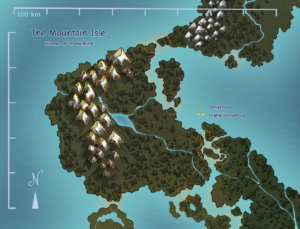Herd Location – The Mountain Isle
Click image for larger view!
Nearly half of the Mountain Isle is occupied by the magnificent Ironcrag mountain range. These peaks may exceed 3,000 meters, while the tallest peak, Elderfront, peaks at around 4,500 meters. Much of the mountain range has an alpine-like climate, with harsh, cool to cold weather year round. The tallest mountain peaks have snow year-round, and in winter the snow line nearly reaches the lowlands. Frosthold is frigid in the mountains with temperatures plummeting well below zero celsius. Even in Sunhigh, though, the temperature will rarely climb higher than 16 celsius. The highest parts of the mountain peaks are some of the most dangerous on the island, as the air quickly becomes thin and phae need to be sure to rest and take their time as they climb.
The transitional land between the mountain and the lowlands is dotted with hot springs resulting from regular geological activity. These are accessible to both Stonemire and the Lowlanders, though Stonemire also keeps a few springs to themselves, as some valleys between mountains also contain these warm pools.
The lower lands of Mountain isle are much calmer and have a comparatively milder climate than the mountain range. The climate is far more similar to a temperate forest, with dense coverage of pine trees near the foothills of the mountain. Maple, walnut, and birch trees are spread across much of the rest of the island. The land is shared between moors, small open plains, and forests. In Rainfall, the moors spring to life with colorful wildflowers, heather, and lavender. Temperatures range from a high around 32 celsius in Sunhigh to -32 celsius in Frosthold. Over the course of the year, the island can easily receive anywhere from 100 – 150 centimeters of rain and snow.
The southernmost point of the island close to Jungle isle has a combination of temperate forest and temperate rainforest climate. Many trees in this area are moss covered, and an ancient grove of redwood trees stretch into the skies. The western coast of the island is left exposed to the brutal winds from the sea, and many rocky, craggy cliffs line this region of the island. The beaches there are usually chilly, and have coarse, rocky sand lining their shores.
Other notable features of the mountain isle are the occasional peat bogs created from year after year of snowmelt floods. On occasion, travelers tell tales of ghostly floating lights that quickly appear and disappear. These will-o’-the wisp are likely created from the emission of methane gas, but some who believe in Orvanna say that they are her breath being released from deep within the earth.
Important Locations
Click image for larger view!
Ironcrag Mountains
The Ironcrag mountains are the backbone of Mountain isle. Stonemire has called the mountain range home for the last two and a half centuries. At least, it did until the recent divide broke the herd up into the main herd (Stonemire or “the Highlanders”) and Lowlanders.
Icewatch
One of the highest peaks in the Ironcrag mountains, Icewatch is the closest to Tundra. Upon its peak sits one of the three beacons Stonemire uses to signal its allies of trouble. Usually these signals are exchanged between the Mountain and Tundra isles.
Elderfrost
The tallest and oldest peak of the Ironcrag mountains, Elderfrost is the shell of a stratovolcano long fallen dormant. Many of the herd believe that either S’ral or Orvanna dwell within the depths of this mountain. Elderfrost also houses an outpost and beacon upon her peak.
Stonereach
One of the southernmost mountains in the Ironcrag mountain range, this mountain is another housing an outpost and a beacon upon her peak. This mountain has a good vantage point for watching both Jungle and the unaffiliated isles between Mountain and Shattered isles.
The Greyheath
The Greyheath is the vast moorland section of the mountain island. This region is densely covered in brush-like growths, and is often populated by heather, lichen, moss, and lavender. In the spring, the moor bursts to life with colorful wildflowers of all sorts of varieties. Countless small cairns dot the landscape of the moor, leading travelers through the rolling hills.
Greenben Forest
This forest comprises a large part of the mountain island, though it is primarily nestled against the eastern side of the Ironcrag mountains. Many cairns can also be seen winding through the underbrush of the forest, leading travelers onwards through the depths of the woods.
Ebonvale Redoubt
Ebonvale Redoubt is a fort built into the mountainside. Much of the structure is wooden, but many caves and paths have been carved out behind it. Several caves lead into the oldest and deepest mines delved by Stonemire. Many of the old caverns have been transformed into living quarters, though most phae prefer to build their own homes. Below the main city is a large valley that is relatively flat. The Snowspill river flows through the valley, leading to the falls themselves. In early Rainfall, this area will flood quickly and festivities are avoided.
Ravenmoor Cairn
The Ravenmoor Cairn sits at a central piece of the Greyheath. Originally an ancient stone fortress from before the raising of the mountains, the Lowlanders quickly reclaimed and rebuilt much of it. It has developed into more of a working and growing community with many inner rooms and houses still intact. A massive redwood tree sits in the heart of the fortress, and much of the foundation is built off of the roots of this great tree.
Ravenmoor houses a library, where what little of the herd’s history was saved has been preserved to be studied by the more scholarly-minded phae. It also houses council chambers for meetings with emissaries or leaders from other herds. The central courtyard is used for herd-wide meetings and a thriving market place is often set up there as well.
Snowspill Falls
This large waterfall collects from the countless snowmelt streams flowing from the highest point of the mountains down into the loch below. The falls flow beside Ebonvale Redoubt, and standing near the edge of the cliff offers a beautiful view of the Lowlands.
Loch Rall
This loch is filled with freshwater flowing directly from the snowmelt off of the mountains. The water is cold year round due to the constant flow from the Snowspill Falls.
Bordering Herds
Stonemire shares a border with Vinelocke to the south and TundraHerdName to the North. They also share an indirect border with Mirroweld via the unaffiliated islands stretching between the Shattered and Mountain isles. Both Stonemire and the Lowlanders have an excellent relationship with TundraHerdName, though Stonemire does tend to do more trade with them. The Lowlanders are far more open to outside contact, and trade regularly with Vinelocke.
Routes to Other Herds
Click image for larger view!
The Mountain Isle is geographically close to both Jungle and Tundra islands, and there are many small islands that can be traversed to cross to another island. There are also several islands between Mountain and the Shattered isles, though this route is far longer to traverse. All of these paths are best taken in steps, as they can become dangerous when the tide is high. At low tide, the sandbars can easily be walked between islands.
Dangerous Areas
Click image for larger view!
In the middle of Frosthold, the peaks of the mountains become extremely treacherous, and even in Sunhigh they are perilous at best. There are few phae that choose to travel the paths leading to the heights of Icewatch, Elderfrost, or Stonereach, and usually only those assigned to watch the beacons dare tread those paths. During Frosthold, many phae assigned to these outposts will hunker down and shelter for the winter, subsisting off of preserved supplies.
The western coast of Mountain isle is also rarely navigated, as the rainshadow has stunted the growth of most plants and trees. Meanwhile, the eastern side of the mountains catches all of the moisture coming in from the ocean, which frequently create vicious gales and updrafts creating massive thunder and snow storms depending on the season. In spring, snow melt will result in flooding with tons of fresh water rushing down waterfalls into the lake at the heart of the island. The eastern coast line can also quickly become dangerous when storms blow in from the sea. This coast is lined with cliffs and rocky shores.
Flora & Fauna
Much of Mountain has a similar climate to the Pacific Northwestern United States, with a smattering of influence from alpine and boreal climates as well. As such, many animals found here have thick, warm coats necessary to survive the freezing temperatures of Frosthold. Many of these animals also have coats that shift colors depending on the temperature and season.
The flora and fauna are in abundance here, so for a more complete list, click this link.
There are many fruits and vegetables growing on Mountain isle, though most consist of dense bushes filled with cranberries, huckleberries, strawberries, thimbleberries, and elderberry as well as rosehips and crabapples. Some of the vegetables are asparagus, camas bulbs, cabbage, leeks, onions, turnips, wild carrots, and parsnips.
Other spices and herbs that grow across the island are nettles, grape roots, wild rose, cedar leaves, dandelion, balm leaves, mustard, sunflowers, watercress, wild licorice, wild mint, and plantain (common & narrow-leaved).
Among the carnivorous animals are wolves, red foxes, bears, coyotes, bobcats, mountain lions, and eagles. Other animals include owls, otters, martins, beavers, rabbits, hares, skunks, squirrels, raccoons, some snakes, ravens, crows, and hummingbirds. Along the shores and in the sea, phae might also find sea otters, sea lions, seals, porpoises, orcas, baleen whales, and the occasional walrus in the north.



